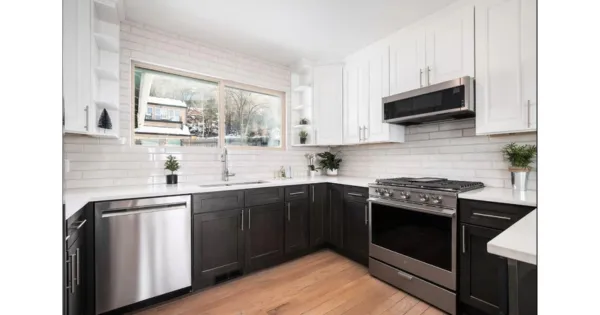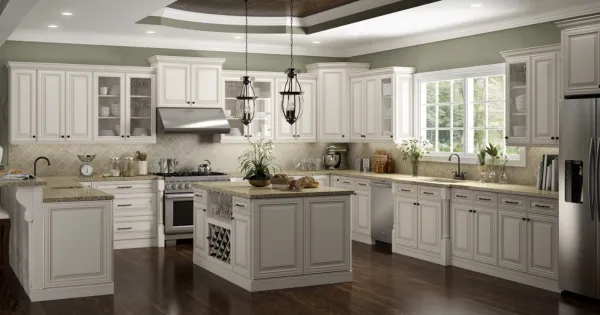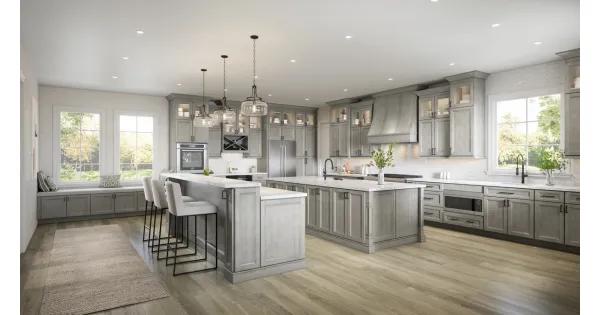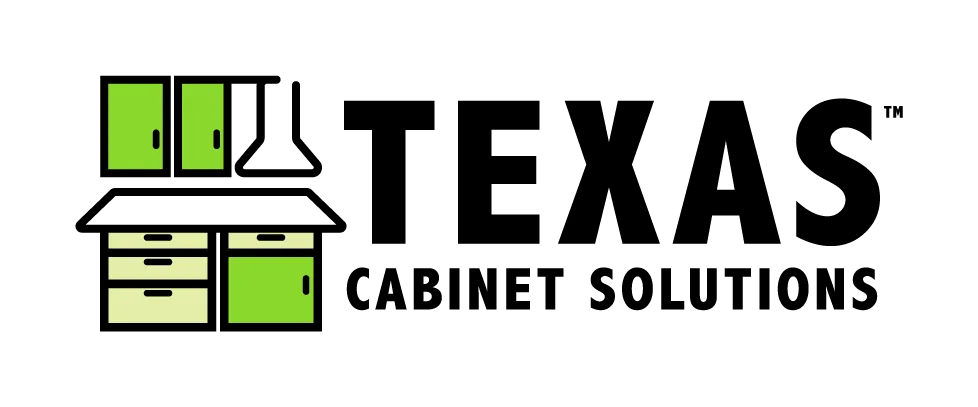Texas Cabinet Solutions
Pricing Guide
Watch this first -->

Example 1
(Price-Conscious)
$15,000 - $17,000
This price range covers smaller projects that focus on simplicity without any add-ons.
Think of a 70-100 sqft. kitchen.
This Option Includes
Professional Design
Guaranteed Price
High-Quality Cabinets
Installation
Optional Add-Ons
Removal of Existing Cabinets
Stacker Cabinets to the Ceiling
Spice Rack Cabinet
Trash Can Cabinet
Decorative Vent Hood
Additional Costs to Consider
Countertops (quoted separately(
Backsplash
Pull Hardware
Flooring
Wall Removal
Electrical
Plumbing

Example 2
(Typical)
$17,000 - $27,000
This price range covers small to medium-sized projects, depending on add-on selection.
Think of a 100-200 sqft. kitchen.
This Option Includes
Professional Design
Guaranteed Price
High-Quality Cabinets
Installation
Up to 3 Add-Ons
Optional Add-Ons
Removal of Existing Cabinets
Stacker Cabinets to the Ceiling
Spice Rack Cabinet
Trash Can Cabinet
Decorative Vent Hood
Additional Costs to Consider
Countertops (quoted separately(
Backsplash
Pull Hardware
Flooring
Wall Removal
Electrical
Plumbing

Example 3
(High-End)
$30,000 - $40,000
This price range covers medium to large projects with several add-ons included.
Think of a 200-400+ sqft, high-end kitchen.
This Option Includes
Professional Design
Guaranteed Price
High-Quality Cabinets
Installation
3+ Add-Ons
Optional Add-Ons
Removal of Existing Cabinets
Stacker Cabinets to the Ceiling
Spice Rack Cabinet
Trash Can Cabinet
Decorative Vent Hood
Additional Costs to Consider
Countertops (quoted separately(
Backsplash
Pull Hardware
Flooring
Wall Removal
Electrical
Plumbing
How Texas Cabinet Solutions Works

How to Get Accurate Cabinet Quotation: A Homeowner's Guide to Affordable Cabinets
Understanding Cabinet Pricing for Your Kitchen Remodel
Embarking on a kitchen renovation project can be exciting and daunting, especially when selecting and pricing cabinetry. With numerous options available and the need to balance quality with affordability, understanding cabinet pricing is crucial for a successful project. This guide will walk you through precise measurements, cabinet style comparisons, custom cabinetry costs, hardware, installation fees, and bathroom vanity quotes, providing essential knowledge for your project budget.
Why Accurate Cabinet Quotation Matter
Before we delve into the specifics, it's essential to understand why obtaining accurate cabinet quotations is crucial. Precise estimates help you plan your budget effectively and ensure that you're comparing apples to apples when evaluating different cabinet options. Accurate quotes can prevent budget overruns, help you make informed decisions about materials and features, ensure a fair price for the desired quality, and avoid surprises and hidden costs during renovation.
When to Consider Professional Measuring Services
While DIY measurements can be sufficient for initial planning, there are situations where professional measuring services can be invaluable for obtaining precise cabinet measurements. Here's when you should consider bringing in the experts:
1. Complex Kitchen Layouts: If your kitchen has unusual angles, curves, or architectural features, professional measurers can capture these nuances accurately.
2. Large-Scale Projects: Even minor measurement errors can compound extensive kitchen renovations or custom cabinetry installations, leading to significant issues.
3. Older Homes: Houses with settled foundations or uneven walls benefit from a professional assessment to ensure a perfect fit.
4. High-End Cabinetry: Professional measurements help protect your investment by ensuring flawless installation when investing in premium custom cabinets.
5. Time Constraints: If you're on a tight schedule, professional measurers can quickly and accurately document your space, saving you time and potential headaches.
6. Lack of Confidence: If you need more clarification about your measuring skills or the proper tools, it's better to rely on professionals than risk costly mistakes.
Many kitchen design firms and cabinet retailers offer professional measuring services, which can provide precise dimensions and note important details such as window and door locations, electrical outlet placements, plumbing and gas line positions, ceiling height variations, and flooring inconsistencies. This thorough observation contributes to an accurate quote and a smoother installation process and identifies potential issues early on for adjustments in the design phase rather than during installation.
Determine Your Cabinet Style and Custom Cabinet Features
Popular Cabinet Styles
When exploring cabinet style comparisons, consider these popular options:
1. Shaker: Known for its clean lines and versatility, the style remains a top choice for many homeowners. It features a five-piece door with a recessed center panel.
2. Flat-panel: "slab" doors offer a sleek, modern look perfect for contemporary kitchens.
3. Raised panel: These traditional doors have a central panel raised above the rest of the door, adding depth and character.
4. Beadboard: Featuring vertical lines, beadboard cabinets add texture and a cottage-like charm to kitchens.
5. Glass-front: Ideal for displaying items, these cabinets can make a kitchen feel more open and spacious.
Each style can significantly affect your cabinet pricing, with more intricate designs typically costing more.
Important Features to Consider
Custom cabinet features can enhance functionality and efficiency in your kitchen. Here are some popular options:
1. Soft-close hinges prevent doors from slamming shut, reducing noise and wear on your cabinets.
2. Pull-out organizers: Perfect for maximizing space in narrow cabinets or hard-to-reach corners.
3. Drawer dividers: Keep utensils and small items organized and easily accessible.
4. Lazy Susans: Ideal for corner cabinets, these rotating shelves make items easy to reach.
5. Spice racks: Built-in storage keeps your seasonings organized and at hand.
6. Trash and recycling pull-outs: Hide unsightly bins while keeping them easily accessible.
7. Vertical dividers: Great for storing baking sheets, cutting boards, and trays.
8. Under-cabinet lighting: Enhances workspace illumination and adds ambiance.
When considering high-quality RTA cabinets, many of these features are available as add-ons, allowing you to customize your kitchen without the high cost of fully custom cabinetry.
Balancing Style and Budget
When comparing cabinet styles and features, prioritize based on your habits. Mix high-end features in high-use areas with more straightforward options in less visible spaces. Look for RTA options balancing style and affordability. Some features, like soft-close hinges, can be added later. Consult with a kitchen designer for cost-effective solutions.
Choose Your Wood Cabinet Materials
Types of Wood and Finishes
1. Oak: Oak is known for its strong grain pattern and durability. It's often less expensive than other hardwoods.
2. Maple: A popular choice for its smooth grain and ability to take on various stains well.
3. Cherry: This fruit is prized for its rich, warm tones that deepen over time. It's typically more expensive.
4. Birch: Often used as a less expensive alternative to maple, with a similar appearance.
5. Hickory: Known for its distinctive grain patterns and strength.
6. Pine: A softwood option that is less expensive but more prone to dents and scratches.
7. Walnut: A premium option known for its deep, rich color and beautiful grain.
Finishes and Their Impact
1. Natural: Showcases the wood's inherent beauty and grain patterns.
2. Stained: Enhances or changes the wood's color while still showing the grain.
3. Painted: Offers unlimited color options but hides the wood grain.
4. Glazed: Adds depth and character, often highlighting door and drawer details.
5. Distressed: Creates an aged or antique look.
Comparing High-Quality RTA Cabinets to Custom Options
High-quality ready-to-assemble (RTA) cabinets are more affordable than custom, offering significant savings. They use the same high-quality materials, such as solid wood doors and plywood construction. RTA cabinets now come in various styles, colors, and sizes. They require assembly, which can be a DIY project or done professionally, while custom cabinets come pre-assembled. High-quality RTA cabinets can be as durable as custom options when correctly assembled and installed. RTA cabinets are often in stock and ready to ship, while custom cabinets may have longer wait times.
Account for Cabinet Hardware Costs
Knobs, Pulls, and Handles: The Finishing Touch
Cabinet hardware might seem like a small detail, but it can significantly impact the look of your kitchen and your overall cabinetry project budget. Here's what you need to know about selecting and budgeting for knobs, pulls, and handles:
1. Many styles, from traditional to modern, have minimalist and ornate options. Some popular finishes include brushed nickel, oil-rubbed bronze, polished chrome, matte black, brass, and copper.
2. Budget options typically range from $2 to $10 per piece, while mid-range options cost between $10 and $30 per piece. If you're looking for high-end designer pieces, be prepared to spend $30 or more per piece.
3. Remember to consider the number of pieces required. To do this, count every drawer and door and decide if larger drawers need two pulls for practicality. Additionally, consider adding knobs to upper cabinets and pulls to lower ones to ensure ergonomic benefits are achieved.
4. It's essential to consider its impact on durability and pricing. Zinc alloy is affordable but less durable, while stainless steel offers a good balance with a mid-range price and excellent durability. On the other hand, solid brass is more expensive but very durable, and it develops a unique patina over time, making it a popular choice for high-quality products.
5. Make sure that the size is proportional. For larger drawers, opt for longer pulls, while for less visually heavy upper cabinets, smaller knobs are recommended. By carefully considering the proportionality of the hardware, you can ensure that it complements your cabinets' overall look and functionality.
6. Investing in durable, high-quality hardware can be a wise decision. Additionally, choosing classic styles for your cabinets can save you money on future updates, as timeless designs tend to remain in fashion and look appealing for many years.
Consider Cabinet Installation Fees
Factors that Affect Installation Pricing
Understanding the variables influencing cabinet installation fees is essential for budget preparation and cost management. Several key factors can impact installation pricing, including the complexity of the kitchen layout, the type of cabinets chosen, the number of cabinets needed, the condition of the existing kitchen, additional features desired, accessibility to the installation area, location, and labor rates, contractor experience and reputation, timing and schedule requirements, extra services, permits and inspections, and material handling.
Prepare a Detailed Project Scope for Your Cabinetry Project Budget
Creating a comprehensive project scope is crucial for obtaining accurate cabinet quotes and controlling your cabinetry project budget. A well-prepared scope helps contractors understand your vision and requirements, leading to more precise estimates and fewer surprises during the project.
List All Requirements and Preferences
1. Cabinet Layout:
- Sketch or CAD drawing of your desired kitchen layout
- Specific cabinet types (base, wall, tall, specialty units)
- Dimensions for each cabinet
2. Cabinet Style and Design:
- Door style (e.g., shaker, flat panel, raised panel)
- Finish type (painted, stained, natural)
- Color preferences
- Hardware style and finish
3. Materials:
- Wood type for cabinet boxes and doors
- Type of drawer slides and hinges
- Countertop material (if part of the cabinet project)
4. Special Features:
- Pull-out organizers
- Lazy Susans
- Spice racks
- Trash/recycling pull-outs
- Soft-close mechanisms
5. Lighting:
- Under-cabinet lighting requirements
- In-cabinet lighting for glass-front cabinets
6. Appliance Integration:
- List of appliances to be incorporated
- Specific requirements for built-in appliances
7. Timeline:
- Desired start and completion dates
- Any time constraints or flexibility
8. Budget:
- Overall budget for the cabinetry project
- Any specific allocations (e.g., more budget for certain high-use areas)
Include Any Unique Challenges or Special Requests
Various factors must be considered when planning a cabinet installation project. These include the structural aspects of the space, such as load-bearing walls that cannot be moved and unique architectural features like sloped ceilings. Access issues, such as narrow doorways, staircases, and parking restrictions for delivery vehicles, should also be considered.
Certain elements may need to be preserved in historic homes. Eco-friendly requests, such as using sustainable materials and energy-efficient lighting, should also be considered. Universal design elements, like accessibility features for special needs, may also need to be incorporated.
Integration with existing elements, such as matching new cabinets to existing woodwork, custom pieces like built-ins, and phased installation are also important considerations. Awareness of local building codes, HOA restrictions, and permits or regulations is crucial. Finally, the disposal of old cabinets, including removal, disposal, or repurposing, should be planned.
Tips for Creating an Effective Project Scope
1. Be as specific as possible to avoid misunderstandings.
2. Use visual aids like photos, sketches, or inspirational images to clarify your vision.
3. Prioritize your requirements to help decision-making if budget adjustments are needed.
4. Consider future needs and plan for potential changes or additions.
5. Consult with a kitchen designer or cabinet specialist to ensure you have noticed essential details.
6. Review and revise your scope before submitting it to contractors for quotes.
Get Multiple Cabinet Quote Comparisons
Why It's Important to Compare
1. Price Variations: Different suppliers and manufacturers may offer significantly different prices for similar products.
2. Quality Differences: Comparing quotes helps you understand the quality-to-price ratio across various options.
3. Service Offerings: Some quotes may include additional services or warranties that add value.
4. Material and Construction Differences: Quotes can reveal variations in materials and construction methods that affect durability and aesthetics.
5. Customization Options: Different providers may offer varying levels of customization within your budget.
Ask the Right Questions for Expert Cabinet Advice
When seeking expert cabinet advice, asking the right questions can help you make informed decisions and avoid potential pitfalls. Here's a guide to the key questions you should ask potential contractors and red flags to watch out for.
Key Questions to Ask Potential Contractors
1. Project-Specific Questions:
- Have you worked on similar projects to mine?
- Can you provide references for recent, similar jobs?
- How would you approach the unique aspects of my kitchen layout?
2. Materials and Quality:
- What materials do you recommend for my project and why?
- How do your cabinets compare to others in terms of quality and durability?
- What type of hinges and drawer slides do you use?
3. Customization Options:
- What level of customization do you offer?
- Can you accommodate specific design requests or unusual dimensions?
4. Installation Process:
- Who will be doing the actual installation?
- What's your typical timeline for a project of this size?
- How do you handle unexpected issues during installation?
5. Warranty and After-Service:
- What warranty do you offer on cabinets and installation?
- How do you handle post-installation service or repairs?
6. Pricing and Payment:
- Can you provide a detailed, itemized quote?
- What's your payment schedule?
- Are there any potential additional costs I should be aware of?
7. Project Management:
- Who will be my main point of contact throughout the project?
- How often will you provide updates on the progress?
8. Preparation and Clean-up:
- What preparations do I need to make before installation begins?
- How do you protect the rest of my home during installation?
- Do you handle the removal and disposal of old cabinets?
9. Compliance and Permits:
- Will you handle any necessary permits for the project?
- Are your cabinets compliant with local building codes?
Red Flags to Watch Out For
While gathering expert cabinet advice, be alert to these warning signs:
1. Pressure to Decide Quickly:
- Beware of contractors pushing for immediate decisions or deposits.
2. Vague or Incomplete Quotes:
- Lack of detail in quotes can lead to unexpected costs later.
3. No Written Contract:
- Always insist on a detailed, written agreement.
4. Unusually Low Bids:
- If a quote is significantly lower than others, question why.
5. Limited or No References:
- Reputable contractors should have a list of satisfied clients.
6. Lack of Proper Licensing or Insurance:
- This can leave you liable for accidents or subpar work.
7. Poor Communication:
- Difficulty reaching the contractor or slow responses can indicate future problems.
8. Reluctance to Discuss Timeline:
- A professional should be able to provide a clear project schedule.
9. Unwillingness to Obtain Permits:
- This could result in legal issues or work that doesn't meet code requirements.
10. Demand for Large Upfront Payments:
- While deposits are common, be wary of requests for large sums upfront.
11. Lack of Clarity on Materials:
- Vagueness about the specific materials can lead to quality issues.
12. Dismissive Attitude Toward Your Concerns:
- A good contractor should address your questions and concerns thoroughly.
Always remember, communication is the key to handling projects to avoid mistakes and re-dos.
Understanding the Kitchen Renovation Costs
Breaking Down the Components of a Cabinet Quote
1. Cabinet Boxes:
- Usually priced per linear foot or unit
- Costs vary based on material (e.g., plywood vs. particleboard)
- Consider the construction method (e.g., dovetail joints may cost more)
2. Cabinet Doors and Drawer Fronts:
- Often, the most expensive component
- Pricing varies by material, style, and finish
- Custom sizes or designs will increase costs
3. Hardware:
- Includes hinges, drawer slides, and knobs/pulls
- Prices range widely based on quality and design
- Soft-close mechanisms may add to the cost
4. Finish:
- Painted finishes are typically more expensive than stained
- Custom colors or multi-step finishes increase costs
- Glazing or distressing adds to the price
5. Interior Accessories:
- Pull-out organizers, lazy Susans, spice racks, etc.
- Can significantly impact the overall cost
- Consider prioritizing based on your needs and budget
6. Installation:
- Usually charged per cabinet or as a percentage of cabinet cost
- Complex layouts or custom work may increase installation fees
7. Delivery:
- May be included or charged separately
- Long-distance or strenuous access can increase costs
8. Design Services:
- Some companies include design fees in the cabinet cost
- Others may charge separately for detailed design work
Hidden Costs to Be Aware Of
1. Removal of Old Cabinets:
- Often not included in standard quotes
- Can be a significant expense, especially if disposal is required
2. Structural Modifications:
- Moving plumbing or electrical for the new layout
- Reinforcing floors or walls for heavy cabinets
3. Permits and Inspections:
- Required in many areas for kitchen renovations
- Costs vary by location and project scope
4. Unforeseen Repairs:
- Water damage, mold, or outdated wiring discovered during removal
- Budget a contingency of 10-20% for unexpected issues
5. Temporary Kitchen Setup:
- Costs associated with creating a makeshift kitchen during renovation
6. Finishing Touches:
- Crown molding, light rail, or other decorative elements
- Often priced separately from the main cabinet order
7. Adjustments to Flooring or Walls:
- New cabinets may require flooring changes or wall repairs
8. Upgraded Lighting:
- Under-cabinet or in-cabinet lighting
- Electrical work for new lighting fixtures
9. Countertop Implications:
- New cabinets often necessitate new countertops
- Consider this cost even if not ordering through the cabinet company
10. Hardware Installation:
- Some companies charge extra for installing knobs and pulls
11. Touch-up Kit:
- For future minor repairs or scratches
- May not be included in the standard quote
12. Extended Warranties:
- Optional additional coverage beyond the standard warranty
13. Customization Fees:
- Charges for modifying standard cabinet sizes or designs
14. Delivery Surcharges:
- For remote locations or difficult access
15. Waste Removal:
- Dumpster rental or hauling fees for renovation debris
Ensuring an Accurate Project Timeline
As we wrap up our comprehensive guide on obtaining accurate cabinet quotes, it's crucial to emphasize the importance of a well-planned project timeline. A realistic timeline helps manage expectations and ensures a smoother renovation process.
A well-executed cabinet project can significantly enhance your home's value and daily life. Take the time to make informed decisions, and don't hesitate to seek expert advice when needed.
Ready to turn your kitchen dreams into reality? Take the next step in your cabinet journey with a free design consultation! Don't let uncertainty hold you back from creating the kitchen you deserve. Schedule your free consultation today, and let us help you navigate the exciting world of kitchen cabinet design. Check other relevant blogs here.

